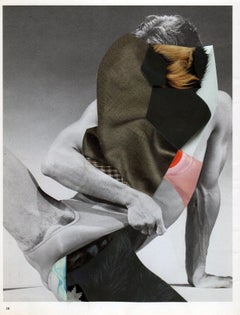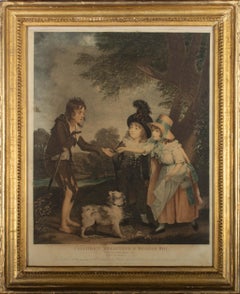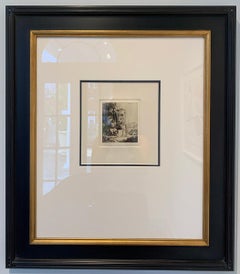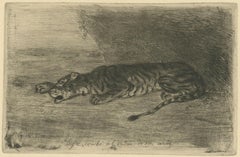Charles Wilkin Art
to
1
1
1
Overall Width
to
Overall Height
to
1
1
1
1
2
1
1
1
1
1
1
1
1
2
9,989
2,754
1,379
1,375
1
1
Artist: Charles Wilkin
Minimal
By Charles Wilkin
Located in New York, NY
This is a photographic collage by the artist Charles Wilkin created in 2020.
Signed
Collage on paper
11 x 8.25 inches
Category
2010s Contemporary Charles Wilkin Art
Materials
Paper
Wilkin after Beechey - 1796 Stipple Engraving, Children Relieving a Beggar Boy
By Charles Wilkin
Located in Corsham, GB
A stipple engraving with etching, coloured in plate, by Charles Wilkin (c.1750-1814) after Sir William Beechey RA's (1753-1839) painting 'Portrait of...
Category
18th Century Charles Wilkin Art
Materials
Engraving
Related Items
'Jesus and the Woman at the Well, ' by Amand-Durand, Engraving
By Armand Durand
Located in Oklahoma City, OK
This early 19th century framed 35" x 31" engraving by artist Amand-Durand depcits an etching of 'Jesus and the Woman at the Well,' after the Dutch master, Rembrandt van Rijn. This poignant Biblical story is depicted by Arman-Durand in Rembrandt style...
Category
Early 19th Century Old Masters Charles Wilkin Art
Materials
Engraving
$1,200 Sale Price
20% Off
H 30.5 in W 26.5 in D 1.5 in
Tigre couché à l'entrée de son antre (Tiger Lying at the Entrance to its Lair)
By Eugène Delacroix
Located in Middletown, NY
Etching, drypoint, and roulette on watermarked Hallines cream laid paper, 3 3/4 x 5 7/8 inches (95 x 148 mm), full margins. A very good impression of this charming image, with all of...
Category
Early 19th Century Realist Charles Wilkin Art
Materials
Laid Paper, Drypoint, Etching
Christ Crowned with Thorns, from The Passion of Christ
By Hendrick Goltzius
Located in Middletown, NY
Engraving on cream wove paper, 8 x 5 3/8 inches (203 x 137 mm), narrow to thread margins. First state (of 2). A fine impression with archival paper adhered at left top and bottom cor...
Category
Early 17th Century Old Masters Charles Wilkin Art
Materials
Engraving
Ghost Souls III • # 1 of 6 • 59 cm x 84 cm
By Angelika Buettner
Located in Aramits, Nouvelle-Aquitaine
Ghost Souls III • 2022 • Edition of 18 prints in 3 different sizes.
A collaboration of photographer Angelika Büttner
and visual artist Laure Laferrerie.
All prints are numbered and ...
Category
2010s Contemporary Charles Wilkin Art
Materials
Archival Paper, Archival Pigment, Digital Pigment
Ghost Souls I • # 3 of 18 • 42 cm x 59 cm
By Angelika Buettner
Located in Aramits, Nouvelle-Aquitaine
Ghost Souls I • 2022 • Edition of 18 prints.
A collaboration of photographer Angelika Büttner
and visual artist Laure Laferrerie.
All prints are numbered...
Category
2010s Contemporary Charles Wilkin Art
Materials
Archival Pigment, Digital Pigment, Archival Paper
The Last Supper, from The Passion of Christ
By Hendrick Goltzius
Located in Middletown, NY
Engraving on cream laid paper, 8 x 5 3/8 inches (203 x 137 mm), trimmed at the platemark. A fine impression with a Coat of Arms watermark. Second state, after the addition of the Frederick de Witt...
Category
16th Century Old Masters Charles Wilkin Art
Materials
Laid Paper, Engraving
"Encuentro" 2006 Original Unique Signed Artist Proof 28x20in Woodcut Mexican
By Antonio Díaz Cortés
Located in Miami, FL
Antonio Diaz Cortes (Mexico, 1935)
'Encuentro' (meeting), 2006
woodcut on paper Velin Arches 300 g.
27.6 x 19.7 in. (70 x 50 cm.)
P/A (Artist Proof), unique piece
Unframed
ID: DIA-10...
Category
Early 2000s Contemporary Charles Wilkin Art
Materials
Ink, Linocut, Woodcut, Engraving
Maybe Yes, Maybe No
Located in Los Angeles, CA
The Art of Seduction, 2023.
Cyanotype Unique Variant Print
Limited Edition of 7
Cyanotype gives a contemporary edge to this flirty dialogue made from vintage magazines, and brings conversation to the counterculture of the "swinging sixties".
+ Cyanotype hand-printed on Arches BFK Rives French watercolor paper
+ Deckled Edges on all four sides
+ Signed and editioned on front in pencil
+ Letter of Authenticity
+ Printed in Los Angeles, CA
WHAT IS A CYANOTYPE?
cyan = blue
type = print
Cyanotype is a historic photographic processes, invented in 1842 and used by Anna Atkins–the first female photographer. The process involves coating watercolor paper with light-sensitive chemistry made of iron salts. Photographic negatives are laid on top, exposed in the sunlight, and then washed in water to develop into the deep Prussian-blue unique to cyanotypes. Brings a moment of beauty and conversation to any space.
ABOUT THE ARTIST:
Alexandra DeFurio...
Category
2010s Contemporary Charles Wilkin Art
Materials
Film, Mixed Media, Watercolor, Magazine Paper, Color, Photogram
Merry-Go-Round
By Reginald Marsh
Located in New York, NY
Reginald Marsh (1898-1954), Merry-Go-Round, etching and engraving, 1938, signed in pencil lower right and inscribed Forty Proofs lower left, [also signed in the plate lower left and inscribed SC]. Reference: Sasowsky 179, fourth state (of 4). In good condition, with margins (a paper loss upper right corner well outside of the platemark, stains from prior hinging, notations in pencil lower margin edge). 10 x 8, the sheet 11 1/2 x 9 1/8 inches.
A very good impression, printed in black on a wove paper with a partial FRANCE watermark.
Sasowsky notes that Marsh printed 15 impressions of this state (and only one or two of the prior states), and considered only 10 of the 15 valuable. His notation “Forty Proofs” is therefore surely an expression of a hoped-for edition size, as opposed to an actual edition size. We have found this quite often the case with Marsh prints – he indicates an edition size but the actual number of impressions printed is considerably smaller.
There is an eerie, almost ominous note in this, as in several of Marsh’s merry-go-round prints...
Category
1930s American Realist Charles Wilkin Art
Materials
Engraving, Etching
Ghost Souls III • # 1 of 3 • 81 cm x 118 cm
By Angelika Buettner
Located in Aramits, Nouvelle-Aquitaine
Ghost Souls III • 2022 • Edition of 18 prints in 3 different sizes.
A collaboration of photographer Angelika Büttner
and visual artist Laure Laferrerie.
All prints are numbered and ...
Category
2010s Contemporary Charles Wilkin Art
Materials
Archival Paper, Archival Pigment, Digital Pigment
Le Cocu Magnifique - Complete Suite of Etchings by Pablo Picasso - 1968
By Pablo Picasso
Located in Roma, IT
In-folio Oblong
Dimensions : 29x39 cm.
Paris
Atelier Crommelynck
1968
Edition of 200 copies including 12 original out-of-text etchings (7 etchings, 4 etchings and acquatint and 1 e...
Category
1960s Cubist Charles Wilkin Art
Materials
Drypoint, Etching, Aquatint
$52,652
H 11.42 in W 15.36 in D 2.17 in
Ghost Souls IV • # 1 of 6 • 59 cm x 42 cm
By Angelika Buettner
Located in Aramits, Nouvelle-Aquitaine
Ghost Souls IV • 2022 • 1/6 • Edition of 18 prints in 2 different sizes.
A collaboration of photographer Angelika Büttner
and visual artist Laure Laferrerie.
All prints are numbered...
Category
2010s Contemporary Charles Wilkin Art
Materials
Archival Paper, Archival Pigment, Digital Pigment
Charles Wilkin art for sale on 1stDibs.
Find a wide variety of authentic Charles Wilkin art available for sale on 1stDibs. You can also browse by medium to find art by Charles Wilkin in engraving and more. Not every interior allows for large Charles Wilkin art, so small editions measuring 21 inches across are available. Customers who are interested in this artist might also find the work of Giovanni Elia Morghen, William Curtis, and Romeyn de Hooghe. Charles Wilkin art prices can differ depending upon medium, time period and other attributes. On 1stDibs, the price for these items starts at $381 and tops out at $381, while the average work can sell for $381.



